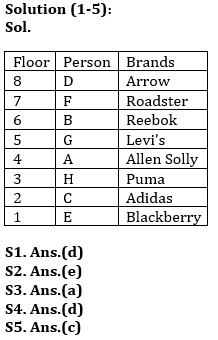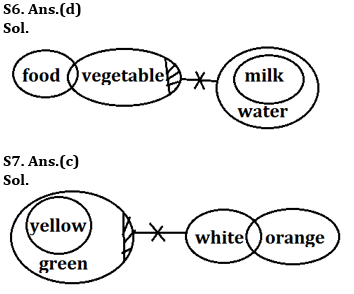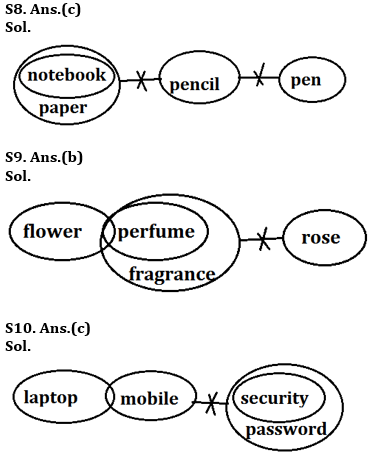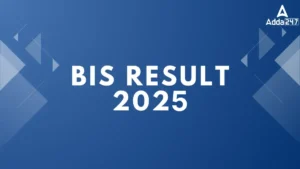Directions (1-5): Study the following information to answer the given questions.
Eight players A, B, C, D, E, F, G and H live on separate floors of an Eight-floor building but not necessarily in the same order. The ground floor is numbered 1, the first floor is numbered 2 and so on till the topmost floor which is numbered as 8. They all like different brands- Roadster, Allen Solly, Levi’s, Puma, Adidas, Reebok, Blackberry and Arrow (but not necessarily
G likes Levi’s and lives on an odd numbered floor but above first floor. The one who likes Reebok lives on an even numbered floor above G. Two persons live between the one who likes Reebok and the one who likes Puma. F likes Roadster. Three persons live between H and F, who lives above H. F does not live on an even numbered floor. C lives immediately above E. D likes Arrow. Three persons live between the one who likes Allen Solly and the one who likes Arrow. B lives above A but not on top floor. The one who likes Adidas lives on an even numbered floor below the one who likes Allen Solly.
Q1. The person who lives on 3rd floor like which of the following brand?
(a)Arrow
(b)Roadster
(c) Allen Solly
(d)Puma
(e)None of these
Q2. How many persons live between D and the one who likes Adidas?
(a) None
(b) Four
(c) Three
(d) Two
(e) More than four
Q3. G lives on which floor?
(a) 5th floor
(b) 3rd floor
(c) 7th floor
(d) 1st floor
(e) 4th floor
Q4. Which of the following is true about B?
(a) B likes Blackberry
(b) B lives immediate above A
(c) Only two persons live between B and E
(d) The one who likes Roadster lives immediate above B
(e) B lives on 4th floor
Q5. Who lives exactly between F and the one who likes Puma?
(a) A
(b) C
(c) The one who likes Levi’s
(d) B
(e) The one who likes Arrow
Directions (6-10): In each question below are given some statements followed by some conclusions. You have to take the given statements to be true even if they seem to be at variance with commonly known facts. Read all the conclusions and then decide which of the given conclusions logically follows from the given statements, disregarding commonly known facts.
Q6. Statements: Some food is vegetable.
All milk is water.
Some vegetable is not water.
Conclusions: I. All milk can never be vegetable.
II. Some vegetable are water.
(a) Only I follows
(b) Both I and II follow
(c) Only II follows
(d) None follows
(e) None of these
Q7. Statements: Some green is not white.
All yellow is green.
Some orange is white.
Conclusions: I. All yellows are orange.
II. Some green are orange is a possibility.
(a) Only I follows
(b) Both I and II follow
(c) Only II follows
(d) Either I or II follows
(e) None follows
Q8. Statements: All notebook is paper.
No paper is pencil.
No pencil is pen.
Conclusions: I. All notebook is pen is a possibility.
II. Some pen are not paper.
(a) Only II follows
(b) Both I and II follow
(c) Only I follows
(d) Either I or II follows
(e) None follows
Q9. Statements: Some flower is perfume.
No fragrance are rose.
All perfume is fragrance.
Conclusions: I. Some flower can never be rose.
II. All fragrance are perfume is a possibility.
(a) Only I follows
(b) Both I and II follow
(c) Either I or II follow
(d) Only II follows
(e) None of these
Q10. Statements: Some laptop is mobile.
All security is password.
No mobile is password.
Conclusions: I. some security are mobile.
II. No mobile is security.
(a) Only I follows
(b) Both I and II follow
(c) Only II follow
(d) Either I or II follows
(e) None of these
Directions (11-15): In these questions, relationship between different elements is shown in the statements. The statements are followed by conclusions. Study the conclusions based on the given statements and select the appropriate answer. Give answer-
(a) If only conclusion I is true
(b) If only conclusion II is true
(c) If both conclusions I and II are true.
(d) If either conclusion I or II is true
(e) If neither conclusion I nor II is true.
Q11. Statements: J<O=B>M, A>Q<J, I≤M.
Conclusions: I. A>M
II. O>I
Q12. Statements: S<Z, R≥C≤Z, Q>S, C>K.
Conclusions: I. R>Q
II. K<R
Q13. Statements: Q>M, J=R, J<Q>S≤A
Conclusions: I. R>M
II. R≤M
Q14. Statements: D≥M>N, Z>D≥R, A>C<R
Conclusions: I. N<Z
II. C<D
Q15. Statements: A≥R, J<A, B>T≥R
Conclusions: I. B<R
II. J>R
Solutions



Solution (11-15):
S11. Ans. (b)
Sol. I. A>M (False) II. O>I (True)
S12. Ans. (b)
Sol. I. R>Q (False) II. K<R (True)
S13. Ans. (d)
Sol. I. R>M (False) II. R≤M (False)
S14. Ans. (c)
Sol. I. N<Z (True) II. C<D (True)
S15. Ans. (e)
Sol. I. B<R (False) II. J>R (False)





 GA Capsule for SBI Clerk Mains 2025, Dow...
GA Capsule for SBI Clerk Mains 2025, Dow...
 The Hindu Review October 2022: Download ...
The Hindu Review October 2022: Download ...
 BIS Result 2024-25 Out for ASO, JSA and ...
BIS Result 2024-25 Out for ASO, JSA and ...





